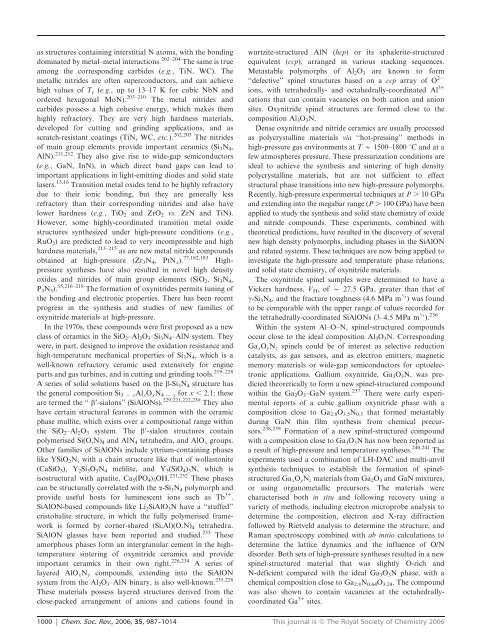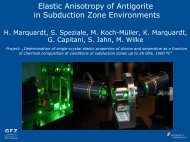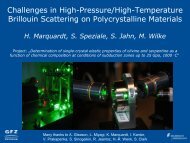High-pressure chemistry of nitride-based materials
High-pressure chemistry of nitride-based materials
High-pressure chemistry of nitride-based materials
You also want an ePaper? Increase the reach of your titles
YUMPU automatically turns print PDFs into web optimized ePapers that Google loves.
as structures containing interstitial N atoms, with the bonding<br />
dominated by metal–metal interactions. 202–204 The same is true<br />
among the corresponding carbides (e.g., TiN, WC). The<br />
metallic <strong>nitride</strong>s are <strong>of</strong>ten superconductors, and can achieve<br />
high values <strong>of</strong> T c (e.g., up to 13–17 K for cubic NbN and<br />
ordered hexagonal MoN). 203–210 The metal <strong>nitride</strong>s and<br />
carbides possess a high cohesive energy, which makes them<br />
highly refractory. They are very high hardness <strong>materials</strong>,<br />
developed for cutting and grinding applications, and as<br />
scratch-resistant coatings (TiN, WC, etc.). 202,203 The <strong>nitride</strong>s<br />
<strong>of</strong> main group elements provide important ceramics (Si 3 N 4 ,<br />
AlN). 211,212 They also give rise to wide-gap semiconductors<br />
(e.g., GaN, InN), in which direct band gaps can lead to<br />
important applications in light-emitting diodes and solid state<br />
lasers. 15,16 Transition metal oxides tend to be highly refractory<br />
due to their ionic bonding, but they are generally less<br />
refractory than their corresponding <strong>nitride</strong>s and also have<br />
lower hardness (e.g., TiO 2 and ZrO 2 vs. ZrN and TiN).<br />
However, some highly-coordinated transition metal oxide<br />
structures synthesized under high-<strong>pressure</strong> conditions (e.g.,<br />
RuO 2 ) are predicted to lead to very incompressible and high<br />
hardness <strong>materials</strong>, 213–215 as are new metal <strong>nitride</strong> compounds<br />
obtained at high-<strong>pressure</strong> (Zr 3 N 4 , PtN x ). 77,182,183 <strong>High</strong><strong>pressure</strong><br />
syntheses have also resulted in novel high density<br />
oxides and <strong>nitride</strong>s <strong>of</strong> main group elements (SiO 2 , Si 3 N 4 ,<br />
P 3 N 5 ). 55,216–218 The formation <strong>of</strong> oxy<strong>nitride</strong>s permits tuning <strong>of</strong><br />
the bonding and electronic properties. There has been recent<br />
progress in the synthesis and studies <strong>of</strong> new families <strong>of</strong><br />
oxy<strong>nitride</strong> <strong>materials</strong> at high-<strong>pressure</strong>.<br />
In the 1970s, these compounds were first proposed as a new<br />
class <strong>of</strong> ceramics in the SiO 2 –Al 2 O 3 –Si 3 N 4 –AlN system. They<br />
were, in part, designed to improve the oxidation resistance and<br />
high-temperature mechanical properties <strong>of</strong> Si 3 N 4 , which is a<br />
well-known refractory ceramic used extensively for engine<br />
parts and gas turbines, and in cutting and grinding tools. 219–228<br />
A series <strong>of</strong> solid solutions <strong>based</strong> on the b-Si 3 N 4 structure has<br />
the general composition Si 3 2 x Al x O x N 4 2 x for x , 2.1; these<br />
are termed the ‘‘ b9-sialons’’ (SiAlONs). 229,221,222,230 They also<br />
have certain structural features in common with the ceramic<br />
phase mullite, which exists over a compositional range within<br />
the SiO 2 –Al 2 O 3 system. The b9-sialon structures contain<br />
polymerised Si(O,N) 4 and AlN 4 tetrahedra, and AlO x groups.<br />
Other families <strong>of</strong> SiAlONs include yttrium-containing phases<br />
like YSiO 2 N, with a chain structure like that <strong>of</strong> wollastonite<br />
(CaSiO 3 ), Y 2 Si 3 O 3 N 4 melilite, and Y 5 (SiO 4 ) 3 N, which is<br />
isostructural with apatite, Ca 5 (PO 4 ) 3 OH. 231,232 These phases<br />
can be structurally correlated with the a-Si 3 N 4 polymorph and<br />
provide useful hosts for luminescent ions such as Tb 3+ .<br />
SiAlON-<strong>based</strong> compounds like Li 2 SiAlO 3 N have a ‘‘stuffed’’<br />
cristobalite structure, in which the fully polymerised framework<br />
is formed by corner-shared (Si,Al)(O,N) 4 tetrahedra.<br />
SiAlON glasses have been reported and studied. 233 These<br />
amorphous phases form an intergranular cement in the hightemperature<br />
sintering <strong>of</strong> oxy<strong>nitride</strong> ceramics and provide<br />
important ceramics in their own right. 226,234 A series <strong>of</strong><br />
layered AlO x N y compounds, extending into the SiAlON<br />
system from the Al 2 O 3 –AlN binary, is also well-known. 235,228<br />
These <strong>materials</strong> possess layered structures derived from the<br />
close-packed arrangement <strong>of</strong> anions and cations found in<br />
wurtzite-structured AlN (hcp) or its sphalerite-structured<br />
equivalent (ccp), arranged in various stacking sequences.<br />
Metastable polymorphs <strong>of</strong> Al 2 O 3 are known to form<br />
‘‘defective’’ spinel structures <strong>based</strong> on a ccp array <strong>of</strong> O 22<br />
ions, with tetrahedrally- and octahedrally-coordinated Al 3+<br />
cations that can contain vacancies on both cation and anion<br />
sites. Oxy<strong>nitride</strong> spinel structures are formed close to the<br />
composition Al 3 O 3 N.<br />
Dense oxy<strong>nitride</strong> and <strong>nitride</strong> ceramics are usually processed<br />
as polycrystalline <strong>materials</strong> via ‘‘hot-pressing’’ methods in<br />
high-<strong>pressure</strong> gas environments at T y 1500–1800 uC and at a<br />
few atmospheres <strong>pressure</strong>. These pressurization conditions are<br />
ideal to achieve the synthesis and sintering <strong>of</strong> high density<br />
polycrystalline <strong>materials</strong>, but are not sufficient to effect<br />
structural phase transitions into new high-<strong>pressure</strong> polymorphs.<br />
Recently, high-<strong>pressure</strong> experimental techniques at P . 10 GPa<br />
and extending into the megabar range (P . 100 GPa) have been<br />
applied to study the synthesis and solid state <strong>chemistry</strong> <strong>of</strong> oxide<br />
and <strong>nitride</strong> compounds. These experiments, combined with<br />
theoretical predictions, have resulted in the discovery <strong>of</strong> several<br />
new high density polymorphs, including phases in the SiAlON<br />
and related systems. These techniques are now being applied to<br />
investigate the high-<strong>pressure</strong> and temperature phase relations,<br />
and solid state <strong>chemistry</strong>, <strong>of</strong> oxy<strong>nitride</strong> <strong>materials</strong>.<br />
The oxy<strong>nitride</strong> spinel samples were determined to have a<br />
Vickers hardness, V H ,<strong>of</strong>y 27.5 GPa, greater than that <strong>of</strong><br />
c-Si 3 N 4 , and the fracture toughness (4.6 MPa m K ) was found<br />
to be comparable with the upper range <strong>of</strong> values recorded for<br />
the tetrahedrally-coordinated SiAlONs (3–4.5 MPa m K ). 236<br />
Within the system Al–O–N, spinel-structured compounds<br />
occur close to the ideal composition Al 3 O 3 N. Corresponding<br />
Ga x O y N z spinels could be <strong>of</strong> interest as selective reduction<br />
catalysts, as gas sensors, and as electron emitters, magnetic<br />
memory <strong>materials</strong> or wide-gap semiconductors for optoelectronic<br />
applications. Gallium oxy<strong>nitride</strong>, Ga 3 O 3 N, was predicted<br />
theoretically to form a new spinel-structured compound<br />
within the Ga 2 O 3 –GaN system. 237 There were early experimental<br />
reports <strong>of</strong> a cubic gallium oxy<strong>nitride</strong> phase with a<br />
composition close to Ga 2.8 O 3.5 N 0.5 that formed metastably<br />
during GaN thin film synthesis from chemical precursors.<br />
238,239 Formation <strong>of</strong> a new spinel-structured compound<br />
with a composition close to Ga 3 O 3 N has now been reported as<br />
a result <strong>of</strong> high-<strong>pressure</strong> and temperature syntheses. 240,241 The<br />
experiments used a combination <strong>of</strong> LH-DAC and multi-anvil<br />
synthesis techniques to establish the formation <strong>of</strong> spinelstructured<br />
Ga x O y N z <strong>materials</strong> from Ga 2 O 3 and GaN mixtures,<br />
or using organometallic precursors. The <strong>materials</strong> were<br />
characterised both in situ and following recovery using a<br />
variety <strong>of</strong> methods, including electron microprobe analysis to<br />
determine the composition, electron and X-ray diffraction<br />
followed by Rietveld analysis to determine the structure, and<br />
Raman spectroscopy combined with ab initio calculations to<br />
determine the lattice dynamics and the influence <strong>of</strong> O/N<br />
disorder. Both sets <strong>of</strong> high-<strong>pressure</strong> syntheses resulted in a new<br />
spinel-structured material that was slightly O-rich and<br />
N-deficient compared with the ideal Ga 3 O 3 N phase, with a<br />
chemical composition close to Ga 2.8 N 0.64 O 3.24 . The compound<br />
was also shown to contain vacancies at the octahedrallycoordinated<br />
Ga 3+ sites.<br />
1000 | Chem. Soc. Rev., 2006, 35, 987–1014 This journal is ß The Royal Society <strong>of</strong> Chemistry 2006





